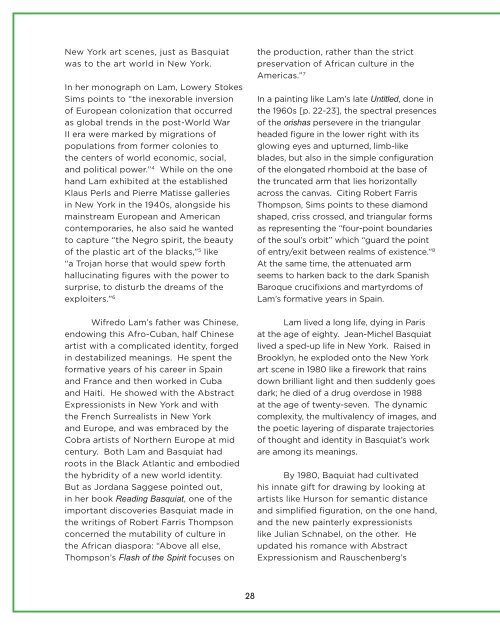Jonathan Fineberg – Additive Aesthetics
Excerpt from “Lam/Basquiat”, a catalog published by Galerie Gmurzynska on the occasion of a special presentation at Art Basel 2015, prepared in collaboration with Annina Nosei.
Excerpt from “Lam/Basquiat”, a catalog published by Galerie Gmurzynska on the occasion of a special presentation at Art Basel 2015, prepared in collaboration with Annina Nosei.
Create successful ePaper yourself
Turn your PDF publications into a flip-book with our unique Google optimized e-Paper software.
New York art scenes, just as Basquiat<br />
was to the art world in New York.<br />
In her monograph on Lam, Lowery Stokes<br />
Sims points to “the inexorable inversion<br />
of European colonization that occurred<br />
as global trends in the post-World War<br />
II era were marked by migrations of<br />
populations from former colonies to<br />
the centers of world economic, social,<br />
and political power.” 4 While on the one<br />
hand Lam exhibited at the established<br />
Klaus Perls and Pierre Matisse galleries<br />
in New York in the 1940s, alongside his<br />
mainstream European and American<br />
contemporaries, he also said he wanted<br />
to capture “the Negro spirit, the beauty<br />
of the plastic art of the blacks,” 5 like<br />
“a Trojan horse that would spew forth<br />
hallucinating figures with the power to<br />
surprise, to disturb the dreams of the<br />
exploiters.” 6<br />
Wifredo Lam’s father was Chinese,<br />
endowing this Afro-Cuban, half Chinese<br />
artist with a complicated identity, forged<br />
in destabilized meanings. He spent the<br />
formative years of his career in Spain<br />
and France and then worked in Cuba<br />
and Haiti. He showed with the Abstract<br />
Expressionists in New York and with<br />
the French Surrealists in New York<br />
and Europe, and was embraced by the<br />
Cobra artists of Northern Europe at mid<br />
century. Both Lam and Basquiat had<br />
roots in the Black Atlantic and embodied<br />
the hybridity of a new world identity.<br />
But as Jordana Saggese pointed out,<br />
in her book Reading Basquiat, one of the<br />
important discoveries Basquiat made in<br />
the writings of Robert Farris Thompson<br />
concerned the mutability of culture in<br />
the African diaspora: “Above all else,<br />
Thompson’s Flash of the Spirit focuses on<br />
the production, rather than the strict<br />
preservation of African culture in the<br />
Americas.” 7<br />
In a painting like Lam’s late Untitled, done in<br />
the 1960s [p. 22-23], the spectral presences<br />
of the orishas persevere in the triangular<br />
headed figure in the lower right with its<br />
glowing eyes and upturned, limb-like<br />
blades, but also in the simple configuration<br />
of the elongated rhomboid at the base of<br />
the truncated arm that lies horizontally<br />
across the canvas. Citing Robert Farris<br />
Thompson, Sims points to these diamond<br />
shaped, criss crossed, and triangular forms<br />
as representing the “four-point boundaries<br />
of the soul’s orbit” which “guard the point<br />
of entry/exit between realms of existence.” 8<br />
At the same time, the attenuated arm<br />
seems to harken back to the dark Spanish<br />
Baroque crucifixions and martyrdoms of<br />
Lam’s formative years in Spain.<br />
Lam lived a long life, dying in Paris<br />
at the age of eighty. Jean-Michel Basquiat<br />
lived a sped-up life in New York. Raised in<br />
Brooklyn, he exploded onto the New York<br />
art scene in 1980 like a firework that rains<br />
down brilliant light and then suddenly goes<br />
dark; he died of a drug overdose in 1988<br />
at the age of twenty-seven. The dynamic<br />
complexity, the multivalency of images, and<br />
the poetic layering of disparate trajectories<br />
of thought and identity in Basquiat’s work<br />
are among its meanings.<br />
By 1980, Baquiat had cultivated<br />
his innate gift for drawing by looking at<br />
artists like Hurson for semantic distance<br />
and simplified figuration, on the one hand,<br />
and the new painterly expressionists<br />
like Julian Schnabel, on the other. He<br />
updated his romance with Abstract<br />
Expressionism and Rauschenberg’s<br />
28
















